| |
|



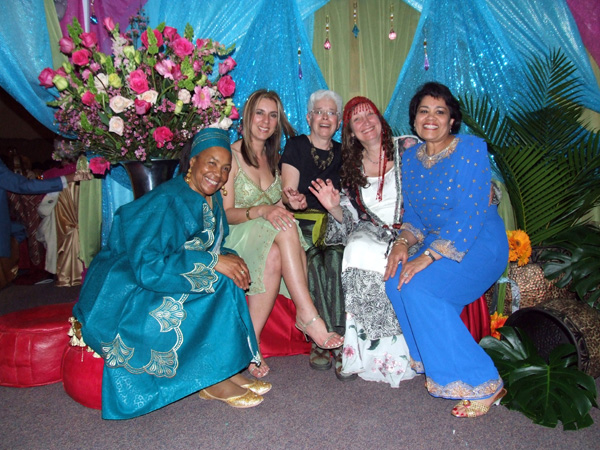
THE JEWISH CITIZEN
Ner Tamid celebrates renewed unity at 'Night at the Kasbah'
By Donald H. Harrison
 POWAY, California—There is a dispute over the name of this inland city in San Diego County: Some say that in an ancient Diegueño Indian language it means meeting place of the two small valleys; others say it refers to two small rivers. Regardless of which, the meeting provided the impetus for great growth. So it was also on Saturday evening, March 8, when American Jewish culture met with that of Morocco in a fundraiser and night of fun that netted Ner Tamid Synagogue approximately $25,000 to fuel its continued growth. POWAY, California—There is a dispute over the name of this inland city in San Diego County: Some say that in an ancient Diegueño Indian language it means meeting place of the two small valleys; others say it refers to two small rivers. Regardless of which, the meeting provided the impetus for great growth. So it was also on Saturday evening, March 8, when American Jewish culture met with that of Morocco in a fundraiser and night of fun that netted Ner Tamid Synagogue approximately $25,000 to fuel its continued growth.
Billed as a "Night at the Kasbah," the gala tapped into the generosity and creativity of the congregants, who starting the previous Sunday had transformed the sanctuary of the Conservative congregation on the hill into a sultan's palace filled with flowing silks, pillows, ornamental brass, and the spicy aromas of Middle Eastern foods. To permit the transformation to proceed, Erev Shabbat and Shabbat morning services were held in the congregation's chapel, which overflowed with worshipers.
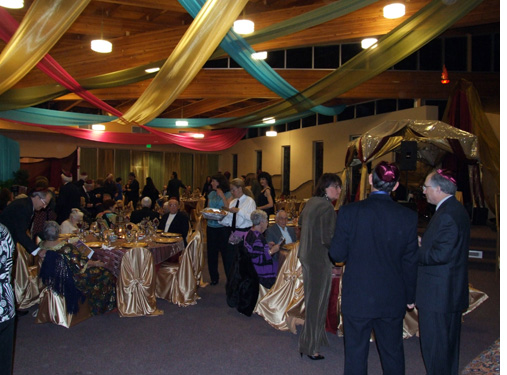 An exultant Mitchell Freedman, the congregational president, joined by congregant Paris Shemirani, greeted arriving guests outside the entrance to the sanctuary. Freedman, who wore a very Western style hat, said the evening reminded him of being at "Rick's Cafe Americain" in the movie Casablanca, although "thankfully without Major Strasser or any other Nazis." An exultant Mitchell Freedman, the congregational president, joined by congregant Paris Shemirani, greeted arriving guests outside the entrance to the sanctuary. Freedman, who wore a very Western style hat, said the evening reminded him of being at "Rick's Cafe Americain" in the movie Casablanca, although "thankfully without Major Strasser or any other Nazis."
He noted that Yasmin Kloeffler, a local textile artist, had provided silks and other fabrics, while Rachel Paksin had made the Moroccan brassware available. "We have people from different parts of the world in our congregation who came together with their ideas," Freedman said. "Volunteers must have put in 200 hours" making the sanctuary ready.
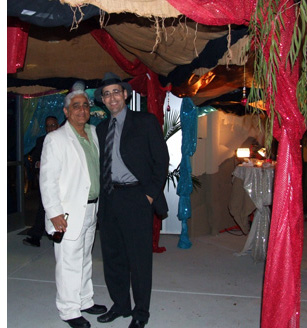 Freedman's elation was quite understandable given the situation he faced last May when, during a time of congregational crisis, he had been drafted as president. Prior to his taking the office, "we had a 'perfect storm.' We had lost our rabbinic leader and we had a deficit of over $100,000, and a real crisis of leadership," he recalled. Freedman's elation was quite understandable given the situation he faced last May when, during a time of congregational crisis, he had been drafted as president. Prior to his taking the office, "we had a 'perfect storm.' We had lost our rabbinic leader and we had a deficit of over $100,000, and a real crisis of leadership," he recalled.
Arguments had seemed to multiply within the disspirited congregation. Nestled on a large property overlooking Pomerado Road, some members thought the congregation should sell some of its land to pay the debts. Others thought the land should be kept. There were also disputes over how much music should be incorporated into Shabbat services.
Since that time the congregation has pulled together. Through the generosity of such members as Howard and Toby Cohen, and the Shemirani family, owners of Barons marketplace, Ner Tamid recently installed a new playground. "We believe it will help the congregation grow as it complements the rest of the campus and provides youngsters a chance to play as well as to pray," said Freedman "We believe young families, who we are acting to reach, want to be sure thier children have a place to play at a synagogue or temple."
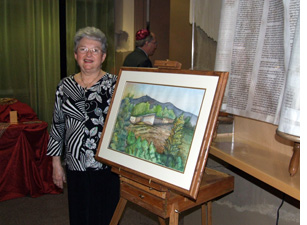 A spirit of donation is in the air, not only of money, but also of art works, photographs, and other creations by congregants united for the synagogue's future. Among them is Leatrice Segel, whose water color of the congregation--as seen from nearby Seacrest Village of Poway—was among the auction items at the gala. A spirit of donation is in the air, not only of money, but also of art works, photographs, and other creations by congregants united for the synagogue's future. Among them is Leatrice Segel, whose water color of the congregation--as seen from nearby Seacrest Village of Poway—was among the auction items at the gala.
American Jewish University (formerly the University of Judaism) rabbinic student Nadav Caine, affectionately called "Rav" by congregants, comes down from Los Angeles to lead services, and even had his wedding ceremony at the synagogue in January. "His father had been a pulpit rabbi for over three decades, and he is a professor of theology who has decided to become a rabbi," Freedman said. "He has tremedous knowledge and humility dealing with people."
So there was much to celebrate, and celebrate the congregants did—their mood considerably heightened by the Moroccan Jewish band of Claude Afota, imported from Los Angeles, and by a belly dancer named Salima, who called both men and women from out of the audience to dance with her. Former congregational president Gerry Burstain, a native of Israel, clearly enjoyed being called back to his Middle Eastern roots, as seen below:




Reflections
Contemplating time travel from the San Diego Library's rare book room
By Sheila Orysiek
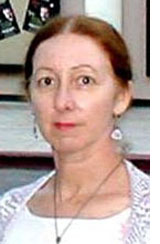 SAN DIEGO—Lloyd Levy’s article “Museum Tablet Corroborates Jeremiah” in the March 7-8, 2008, edition of San Diego Jewish World, reminded me of the years I spent as a docent in the Wangenheim Room which houses the collection of old and/or rare books at the San Diego Public Library. There is a noteworthy collection of Hebrew Scriptures, (including the Book of Esther in Hebrew) some of which were on display at the recent Dead Sea Scrolls Exhibition at the Natural History Museum in San Diego. The collection in the Wangenheim Room also displays books other than the bound books with which most of us are familiar; scrolls, cylinders, wooden slatted books, and so forth. SAN DIEGO—Lloyd Levy’s article “Museum Tablet Corroborates Jeremiah” in the March 7-8, 2008, edition of San Diego Jewish World, reminded me of the years I spent as a docent in the Wangenheim Room which houses the collection of old and/or rare books at the San Diego Public Library. There is a noteworthy collection of Hebrew Scriptures, (including the Book of Esther in Hebrew) some of which were on display at the recent Dead Sea Scrolls Exhibition at the Natural History Museum in San Diego. The collection in the Wangenheim Room also displays books other than the bound books with which most of us are familiar; scrolls, cylinders, wooden slatted books, and so forth.
As a volunteer I sat in the beautiful room so it could be kept available for the general public; otherwise the room is only opened upon request as the public is not allowed in without supervision by the staff and/or a docent volunteer. To occupy my time I usually read, had interesting conversations with the rare book librarian/archivist, but periodically I was given a specific task.
On one occasion the archivist asked me to place and catalogue rocks in a sculptured box - much like an egg carton. These were not just any old rocks - they were tablets upon which cuneiform (winged) writing had been carved - some over four thousand years ago.
So, there I sat at a polished wood conference table, antique Persian carpets at my feet, surrounded by paintings, sculptures and display cases with collections of miniature books, beautiful fore-edge-painted books, ancient books, and other artifacts of literate societies through the centuries from around the world. And, in front of me these tablets upon which were the delicate inscriptions from millennia ago; the hand that carved them long turned to dust - a reminder that I, too, am finite and will most probably not be leaving as lasting an item behind. It is not improbable that some of these might have been inscribed by a Jewish hand sojourning in Babylon.
I have read that many of the cuneiform tablets are business and tax records kept by officials and ordinary shopkeepers. It is quite an amazing thing to hold in one’s palm an item that was absolutely held in another human hand so long ago - in a much different world. How do our worlds compare? Surely, “he” (assuming for the sake of literary convenience it was a “he”) would find my world incomprehensible.
I can picture him sitting in the sunshine in front of his shop in the ancient city of Babylon; the street which he looks out upon is busy, hot, and dusty. People walk by; cry out their wares, carts, horses, dogs, and children - people congregating at a well, or having their bread baked at a communal oven. A small flock of sheep go by, a goat or two, maybe a chariot carrying some potentate. He - this inscriber of the rock - talks to his customers, disciplines his children, hopes his wife will cook something he likes for his dinner. Maybe a small cup of wine soothes a headache he feels coming on.
Were I to be transported back to his time - I’d surely be jarred, but would recognize what I see. I’m not used to observing an animal being slaughtered and then butchered, but do understand this process takes place before I make my purchase at the supermarket. I don’t go to a well for water, but do understand what wells are for. I don’t believe that the doctor’s spells will cure me - or some concoction of animal horn either - but I do know that it is his goal to help me. I do know that studying the entrails of an animal is not an accurate way to foretell the future, but also understand that people have a need to - want to - know.
So, on the whole, though I’d surely miss my amenities (aspirin, microwave, flush sanitation, speed of travel, etc.) I could adjust - I probably wouldn’t spend much time in awe and wonder. But what if that long ago inscriber came to my time? How could I explain how all that stuff gets to the supermarket - from around the world; grapes, flowers traveling from a place (like Argentina to San Diego) thousands of miles away and arrives still looking fresh?
Can I explain refrigeration on a blistering hot day? Would he believe the internet - that I can communicate with literally anyone anywhere at anytime? That big thing humming along a track is a train that speeds on electricity which can neither be seen nor heard and it’s the same thing that cooks my food, lights the city, washes clothes and brings music and images of people into my house? And that thing up in the sky is neither a giant bird nor an alien god, but a plane filled with people going on vacations across the world. He might ask me: “What’s a vacation?”
And men on the moon, go-carts wheeling around on Mars - how can I get him to accept that? If he gets hurt or sick - how to keep him from being terrified of entering an operating room, get an MRI - or to sit in a dentist’s chair and allow a high speed drill in his mouth? As for telling the future - well, sometimes the weather report doesn’t get it right (all those expensive weather satellites notwithstanding) but just as often does tell us a storm is approaching. And, sometimes DNA tells us what’s possibly in our future or who fathered a child or committed a crime - can he fathom that?
Would it be possible for this person to adjust to my time? I think he would have a hard time of it - but he would eventually, I suppose. On the other hand, I think that though initially I’d have an easier time understanding his society, I’d have a harder time adjusting. It’s easier accepting virtually painless dentistry or surgery than doing without it.
One of the things he might find difficult is the insular nature of our society. We don’t work and live in the same place - we commute. We don’t sit in front of our shops and commune with our friends, neighbors and customers. We don’t always know our neighbors who live just across the street. We don’t make things to order (generally speaking) we buy what is already made and we don’t usually know who made it. China is no longer an exotic destination of the Silk Road, but a ubiquitous supplier of much of what we consume.
We eat our fruit and salad cold; our milk skimmed and homogenized, white bread, refined sugar. Though we think it’s a wonderful idea to vote for our leaders we don’t really know who they are - and it doesn’t matter anyway, since they usually aren’t who they tell us they are.
We don’t write on rocks, we write on paper so we can throw it away, or in a medium that has even less substance which we look at on a lighted screen (which isn’t really a screen) that disappears into even less substance at the click of a mouse which isn’t a mouse at all.
But some things don’t change - there is still good and evil in the world. There are still people around who always want what someone else has, or want to control what others think or cast aspersions upon conclusions that are different than their own. We do this as individuals as well as nations and societies. We often come to blows - lobbed from thousands of miles away in the middle of the ocean. Only the means of exchanging blows has changed.
I’m glad I don’t live in “his” time; but I can readily think of a number of improvements for my own and one of them is forbearance - hesitate before condemning - there is more than one way to inscribe a cuneiform rock. And I can’t think of much in my time that will last as long as that winged writing on a stone tablet - except death and taxes.
DOING IT BETTER
The nail that gets hammered down first
By Natasha Josefowitz, Ph.D.
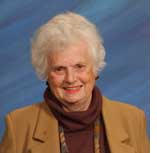 LA JOLLA, California—“The nail that sticks out gets hammered down first” is an old Japanese proverb. It means that the most visible person is the one who gets the “pot shots.” LA JOLLA, California—“The nail that sticks out gets hammered down first” is an old Japanese proverb. It means that the most visible person is the one who gets the “pot shots.”
It’s the most successful person with a high profile: the celebrity, the richest man, the best-dressed woman, who gets the media coverage. As soon as you’re in the public eye, someone is going to dig up some dirt, whether true or not. Even if proven wrong, the damage is done.
Several of my women friends who have successfully published keep a low profile to not incur the envy of their less successful peers. This is pervasive in all walks of life. It isn’t how much we have; it is how much or how little we have compared to someone else. “Keeping up with the Joneses” is an interesting competitive phenomenon. I can be perfectly happy with my lawn until your lawn looks better. Then all of a sudden my lawn, that was green enough yesterday, looks brown today. Very few of us can be truly happy with the success of a friend if we ourselves wish for recognition but have not received it.
This creates a dilemma in the workplace. The person who moves up, leaving co-workers behind, will incur jealousy. I know of quite a few women who would rather not get promoted and thus lose the friendship of co-workers. Newly promoted people have no colleagueship until they can forge new relationships, which takes time. They are often the victims of isolation from former friends who wonder why this particular person is getting ahead instead of themselves.
Research has shown that friendly co-workers are more important than salary or promotions. So it is no wonder that one has to carefully evaluate one’s goals before deciding upon the next steps. If the hope is to keep moving up, then there are several strategies available. One of the more important ones is visibility. You have to be noticed by your boss, by his boss, and by all the higher-ups in the organization.
This push to be noticed is also noticed by your co-workers who will resent the elbowing. There is a price to pay, and that is others’ irritation with you and an unpleasant atmosphere at work.
Sadly enough, quiet competence seldom gets anyone anything unless there is someone to blow your horn. If there is no one to do it for you (that’s where mentors come in) then you have to do it yourself. Anything that you do that is different from others will incur sanctions from your peers. If you suggest ideas to improve cost-cutting or offer to stay late to help out with some project, your motives will immediately become suspect.
Most people feel inadequate in some hidden part of themselves and wonder whether they will be found out. I call it “the secret fraud lurking inside.” I have certainly felt that way at the beginning of my teaching career. It takes a lot of self-confidence to put oneself ahead of others, and it make the less self-assured people feel bad about their own lack of drive. If someone makes you feel inadequate, you will resent that person and show it. This will be noticed by the self-confident person and make him or her somewhat less so, and thus the balance is restored. I like the statement by Eleanor Roosevelt, “No one can make you feel inferior without your consent.”
But getting ahead need not be everyone’s goal. The added hours and responsibilities may not be everyone’s idea of a wonderful thing. It is perfectly all right to wish to stay put in a secure and predictable environment, surrounded by co-workers you’ve grown fond of. Being disliked may be too high a price to pay for many people, and very few who have made it to the top are liked. Respected, yes, appreciated, maybe—but liked? Not very often.
We have all heard about the lonely spot at the top where that person never knows if friendship is genuine or offered only for a hoped for exchange of favors.
Each of us has to decide what is more important for ourselves. It is a life decision that is not immutable. It can be one way today and the opposite tomorrow. Either way is fine as long as your choice is conscious—knowing the advantages and disadvantages of the decision. Say to yourself: “This is who I am today and this is what is right for me at this time in my life.” Tomorrow is up for grabs.” And don’t let anyone tell you otherwise.
SAN DIEGO JEWISH WORLD THE WEEK IN REVIEW
Judy Lash Balint in Jerusalem: Mercaz Harav central to Israeli life
Shoshana Bryen in Washington, D.C.: Shootings should end the 'Peace Process'
Carol Davis in San Diego: Snobs eschew The American Plan
Peter Garas in Canberra, Australia: Hey mate, opportunity in Australia
Donald H. Harrison in San Diego: Shor, 6, meets His Honor, The Mayor
Rabbi Baruch Lederman in San Diego: Some thoughts for those at a shiva
Dov Burt Levy in Salem, Massachusetts: Barack Obama, political nudniks and me
Rabbi Leonard Rosenthal in San Diego: The unending need for tzedakah
Shoshana Bryen in Washington, D.C.: Question to Olmert: Is Bush agenda yours?
Rabbi Yeruchem Eilfort in Carlsbad, California: Pain of Jerusalem murders is white hot
Lloyd Levy in London: Museum tablet corroborates Jeremiah
Sheila Orysiek in San Diego: The Sabbath’s Omnipotent Painter
Rabbi Peter Tarlow in College Station, Texas: Huánuco, Peru, is planning for March 14 its first Jewish service in over a century
Sherry Berlin in San Diego: Sarah laughs...and Sammy enjoys Shavuot
Donald H. Harrison in San Diego: Mafia 'wise guy' converts to Judaism
Sheila Orysiek in San Diego: Choreographer seeks to
decentralize dance
from New York City, make it more eclectic
Carol Davis in San Diego: The Clean House plays to a pleased house
Peter Garas in Canberra, Australia: Double standard: journalists shed no tears for Ukrainians denied Russian heating oil
Yvonne Greenberg in San Diego: Lecturer says Sydney Taylor’s children’s books intrigue audiences of all ages
Donald H. Harrison in San Diego: The Zoo as textbook for religious studies
heila Orysiek in San Diego: Kaballah book helps open ears to the Voice
Marissa Palin in San Diego: Beth Israel event focuses on auto emissions
Gary Rotto in San Diego: Surrogates for Clinton and Obama debate for the affection of Ohio Jewish voters
Lynne Thrope in La Jolla, California: Whisknladle: restaurant gets it right
Link to previous editions
< BACK TO TOP
|
|

 —
—